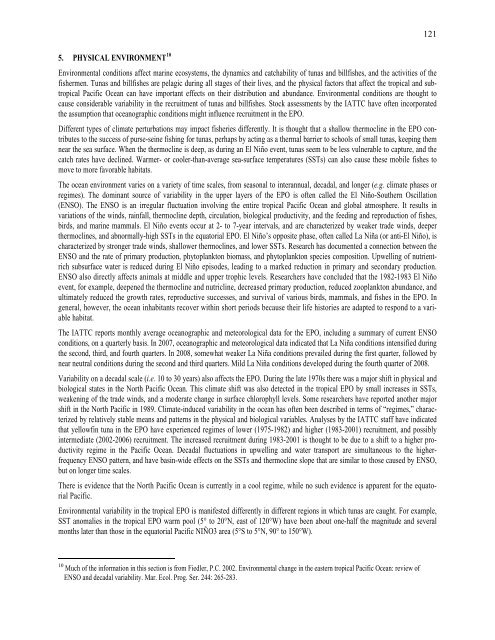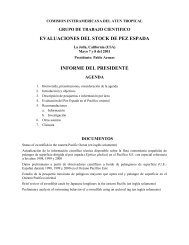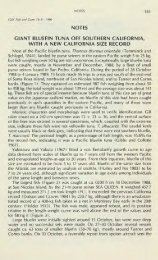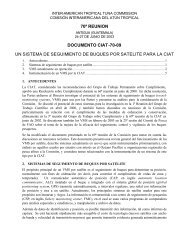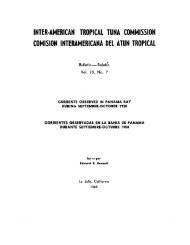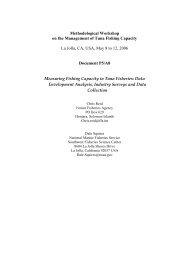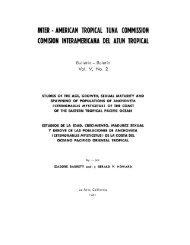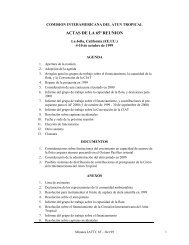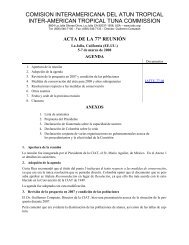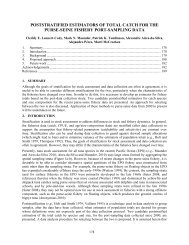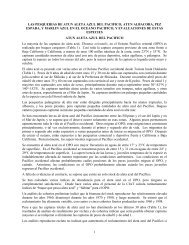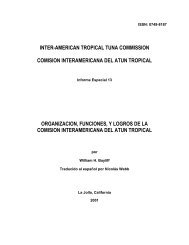INTER-AMERICAN TROPICAL TUNA COMMISSION - Comisión ...
INTER-AMERICAN TROPICAL TUNA COMMISSION - Comisión ...
INTER-AMERICAN TROPICAL TUNA COMMISSION - Comisión ...
- No tags were found...
Create successful ePaper yourself
Turn your PDF publications into a flip-book with our unique Google optimized e-Paper software.
5. PHYSICAL ENVIRONMENT 10Environmental conditions affect marine ecosystems, the dynamics and catchability of tunas and billfishes, and the activities of thefishermen. Tunas and billfishes are pelagic during all stages of their lives, and the physical factors that affect the tropical and subtropicalPacific Ocean can have important effects on their distribution and abundance. Environmental conditions are thought tocause considerable variability in the recruitment of tunas and billfishes. Stock assessments by the IATTC have often incorporatedthe assumption that oceanographic conditions might influence recruitment in the EPO.Different types of climate perturbations may impact fisheries differently. It is thought that a shallow thermocline in the EPO contributesto the success of purse-seine fishing for tunas, perhaps by acting as a thermal barrier to schools of small tunas, keeping themnear the sea surface. When the thermocline is deep, as during an El Niño event, tunas seem to be less vulnerable to capture, and thecatch rates have declined. Warmer- or cooler-than-average sea-surface temperatures (SSTs) can also cause these mobile fishes tomove to more favorable habitats.The ocean environment varies on a variety of time scales, from seasonal to interannual, decadal, and longer (e.g. climate phases orregimes). The dominant source of variability in the upper layers of the EPO is often called the El Niño-Southern Oscillation(ENSO). The ENSO is an irregular fluctuation involving the entire tropical Pacific Ocean and global atmosphere. It results invariations of the winds, rainfall, thermocline depth, circulation, biological productivity, and the feeding and reproduction of fishes,birds, and marine mammals. El Niño events occur at 2- to 7-year intervals, and are characterized by weaker trade winds, deeperthermoclines, and abnormally-high SSTs in the equatorial EPO. El Niño’s opposite phase, often called La Niña (or anti-El Niño), ischaracterized by stronger trade winds, shallower thermoclines, and lower SSTs. Research has documented a connection between theENSO and the rate of primary production, phytoplankton biomass, and phytoplankton species composition. Upwelling of nutrientrichsubsurface water is reduced during El Niño episodes, leading to a marked reduction in primary and secondary production.ENSO also directly affects animals at middle and upper trophic levels. Researchers have concluded that the 1982-1983 El Niñoevent, for example, deepened the thermocline and nutricline, decreased primary production, reduced zooplankton abundance, andultimately reduced the growth rates, reproductive successes, and survival of various birds, mammals, and fishes in the EPO. Ingeneral, however, the ocean inhabitants recover within short periods because their life histories are adapted to respond to a variablehabitat.The IATTC reports monthly average oceanographic and meteorological data for the EPO, including a summary of current ENSOconditions, on a quarterly basis. In 2007, oceanographic and meteorological data indicated that La Niña conditions intensified duringthe second, third, and fourth quarters. In 2008, somewhat weaker La Niña conditions prevailed during the first quarter, followed bynear neutral conditions during the second and third quarters. Mild La Niña conditions developed during the fourth quarter of 2008.Variability on a decadal scale (i.e. 10 to 30 years) also affects the EPO. During the late 1970s there was a major shift in physical andbiological states in the North Pacific Ocean. This climate shift was also detected in the tropical EPO by small increases in SSTs,weakening of the trade winds, and a moderate change in surface chlorophyll levels. Some researchers have reported another majorshift in the North Pacific in 1989. Climate-induced variability in the ocean has often been described in terms of “regimes,” characterizedby relatively stable means and patterns in the physical and biological variables. Analyses by the IATTC staff have indicatedthat yellowfin tuna in the EPO have experienced regimes of lower (1975-1982) and higher (1983-2001) recruitment, and possiblyintermediate (2002-2006) recruitment. The increased recruitment during 1983-2001 is thought to be due to a shift to a higher productivityregime in the Pacific Ocean. Decadal fluctuations in upwelling and water transport are simultaneous to the higherfrequencyENSO pattern, and have basin-wide effects on the SSTs and thermocline slope that are similar to those caused by ENSO,but on longer time scales.There is evidence that the North Pacific Ocean is currently in a cool regime, while no such evidence is apparent for the equatorialPacific.Environmental variability in the tropical EPO is manifested differently in different regions in which tunas are caught. For example,SST anomalies in the tropical EPO warm pool (5° to 20°N, east of 120°W) have been about one-half the magnitude and severalmonths later than those in the equatorial Pacific NIÑO3 area (5°S to 5°N, 90° to 150°W).12110 Much of the information in this section is from Fiedler, P.C. 2002. Environmental change in the eastern tropical Pacific Ocean: review ofENSO and decadal variability. Mar. Ecol. Prog. Ser. 244: 265-283.


